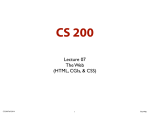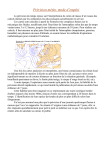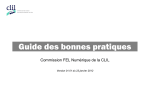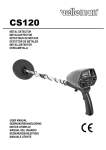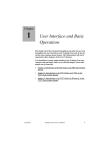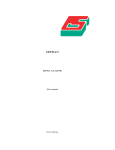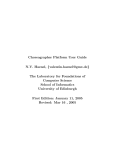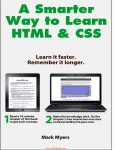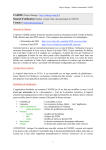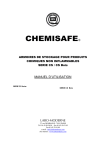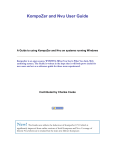Download as 1-up pdf - School of Computer Science Student WWW Server
Transcript
CS 200
Lecture 07
The Web
(HTML, CGIs, & CSS)
CS 200 Fall 2013
Monday, October 28, 2013
1
The Web
Miscellaneous Notes
Abbreviations
aka
Also Known As
CSS
Cascading Style Sheets
CWS
Course Web Site
Reading
Learning Web Design (2/e, library reserve)
Extracts from HTML & XHTML (5/e) — The Definitive Guide, Chapter 8 on Cascading Style Sheets
also available online from the University at http://safari.ora.com > MY BOOKSHELF – Book 27
Western Civilization’s tutorial on CSS properties (for reference)
http://www.westciv.com/style_master/academy/css_tutorial/introduction/css_intro.html
Sitepoint’s CSS Introduction and Documentation (for reference)
http://reference.sitepoint.com/css
The “Cascading Style Sheet Properties Quick Reference” (for reference)
in HTML & XHTML (5/e) The Definitive Guide, available online at http://proquest.safaribooksonline.com/ Book 27
CSS Pocket Reference (3/e), by Eric Meyer, O’Reilly & Associates (book store)
Optional background reading
Web Style Guide, by Lynch & Horton, Yale Univ Press, 0-300-07675-4 (Library Reserves)
Web Style Guide (2/e), by Lynch & Horton, Yale Univ Press, 0-300-09682-8
Optional reference text
CSS — The Definitive Guide (3/e), by Eric Meyer, O’Reilly, ISBN 0-596-52733-0 (Safari Books Online > Book 10)
CS 200 Fall 2013
Monday, October 28, 2013
2
The Web
Administrivia
Please read and high-light, before lab:
•
•
Assignment 7
This week’s slides
There are hyper-text commented source files for many of the web pages used in this lecture
•
Handouts > Commented HTML on the CWS
Major topics today
•
•
•
•
•
•
•
read and recall pearl
the client-server paradigm
putting HTML in context
relative vs absolute URLs
tables as a layout tool
forms
styles in HTML (esp cascading style sheets)
Today’s lecture assumes an elementary understanding of HTML tags & attributes (eg from CS 100)
•
if you lack it, see Learning Web Design, or www.htmlCodeTutorial.com
CS 200 Fall 2013
Monday, October 28, 2013
3
The Web
Road Map
New applications for this week
•
PageSpinner
a Mac-only HTML editor
•
EditiX
a cross-platform XML editor
•
StyleMaster
a cross-platform CSS editor
This week’s lecture builds on the preceding weeks’ material
•
•
•
tables
styles
graphics
CS 200 Fall 2013
Monday, October 28, 2013
4
The Web
The Read ‘n Recall Pearl
Dialogs and Menus
•
•
•
Menus
Dialogs
Toolbars & Palettes
Documentation
•
•
•
The user manual
Online help
Online tutorials
CS 200 Fall 2013
Monday, October 28, 2013
5
The Web
Client-Server File Sharing
EG the AppleShare file Server on Oscar
•
•
•
•
•
your lab Mac is the “client:” slower, cheaper, smaller disks
oscar is the “server machine:” faster, more expensive, bigger disks
AppleShare is the “server application,” running on the server machine
“share points” are folders on the server that are made available over the network
“network disks”
“mounting” a share point (use the Finder’s Go > Connect to Server... menu item)
creates a “network disk” on your client machine
an icon appears on the desktop, just as for a local disk
use a network disk just like a local disk, although it’s a bit slower
•
“network folders”
these are subfolders (aka subdirectories) of a network disk
eg 101BeaJ_main is my “cs200main network folder”
unlike the other terms on this slide, “network folder” is a CS200-invented term
As distinct from “peer-to-peer” file sharing
CS 200 Fall 2013
Monday, October 28, 2013
6
The Web
The Web (like file-sharing) has a client-server model
Many of the machines on the Internet are “web servers”
•
•
any machine (“client”) on the web can ask them for data
200
request
.html
actually, they’re asking a particular application
running on that machine for data
(which is identified by a “port”)
oscar.cs.uwaterloo.ca
(Server)
Exp
.html
Web
Server
Schedule
.html
The client uses a “browser” to request & display web pages
•
•
eg Firefox, Safari, Netscape, Explorer, Camino, Opera, ...
browsers decide how to render the HTML, based on
HTML tags found in the document
what kind of display is available
user preferences
•
Lab Macintoshes (Clients)
browsers are often (but not always) consistent in how they do this
For security
•
•
•
a web server can only return files in the “server subtree”
sometimes that’s rooted in the folder holding the server app
The default Mac OS X web server application (Apache) is at /usr/sbin/httpd;
the default web document root folder is at /Library/WebServer/Documents/.
usually this “web root folder” can be set
when the web server is started
CS 200 Fall 2013
Monday, October 28, 2013
7
The Web
Data Returned By Web Servers
The files returned can be
•
•
•
web pages
pictures
other stuff...
A “web page” is a TEXT file containing
•
•
text to be displayed (text “elements”)
“tags”
eg <html> and <p> that control presentation of the text—they’re really styles
“links” containing “URLS” (eg <a href="• • •"> and <img src="• • •">)
to other web pages
to graphics, for display on the page
to sounds, to be played when the page is viewed
etc—add post-install “plugins” to handle new file types
(/Library/Internet Plug-Ins/ or ~/Library/Internet Plug-Ins/ on Macs)
•
URL = Uniform Resource Locator (eg “jcbServer.cs.uwaterloo.ca/cs200/index.html”)
(aka URI = Uniform Resource Indicator—yuck)
CS 200 Fall 2013
Monday, October 28, 2013
8
The Web
Formatting Tags in WordPerfect
T
What you see here are “property tags”
but they could equally well be (named) style tags
Strip out all the formatting codes
to get a “text” or “ascii” file
CS 200 Fall 2013
Monday, October 28, 2013
9
The Web
Formatting Tags in WordPerfect
T
What you see here are “property tags”
but they could equally well be (named) style tags
Strip out all the formatting codes
to get a “text” or “ascii” file
CS 200 Fall 2013
Monday, October 28, 2013
9
The Web
A Toy Web Page
CS 200 Fall 2013
Monday, October 28, 2013
10
The Web
A Toy Web Page
The HTML for this web page
<HTML><HEAD><TITLE>Jen's Fake Home Page</TITLE></HEAD><BODY bgcolor="#FFFFFF"><IMG SRC="star.gif"><IMG
SRC="JenBanner.gif"><IMG SRC="star.gif"><CENTER><H2>Welcome to my Web page</H2></CENTER><IMG SRC="Exclamation.gif"
ALIGN=left HSPACE=6><P><STRONG>Warning!</STRONG> This is not my <EM>real</EM> home page. It's just a little something I
made up for the occasion. But just in case you're interested, I'll tell you a bit about me.</P><HR><H2>Places I've Lived</H2><UL><LI>
Akron, OH</LI><LI>Hudson, OH</LI><LI>Sourth Bend, IN</LI><LI>Boston, MA</LI></UL><P style="font-size:80%">(Adapted from
"Designing for the Web - Getting Started in a New Medium" by Jennifer Niederst and Edie Freedman.)</P></BODY></HTML>
CS 200 Fall 2013
Monday, October 28, 2013
10
The Web
A Toy Web Page
The HTML for this web page
<HTML><HEAD><TITLE>Jen's Fake Home Page</TITLE></HEAD><BODY bgcolor="#FFFFFF"><IMG SRC="star.gif"><IMG
SRC="JenBanner.gif"><IMG SRC="star.gif"><CENTER><H2>Welcome to my Web page</H2></CENTER><IMG SRC="Exclamation.gif"
ALIGN=left HSPACE=6><P><STRONG>Warning!</STRONG> This is not my <EM>real</EM> home page. It's just a little something I
made up for the occasion. But just in case you're interested, I'll tell you a bit about me.</P><HR><H2>Places I've Lived</H2><UL><LI>
Akron, OH</LI><LI>Hudson, OH</LI><LI>Sourth Bend, IN</LI><LI>Boston, MA</LI></UL><P style="font-size:80%">(Adapted from
"Designing for the Web - Getting Started in a New Medium" by Jennifer Niederst and Edie Freedman.)</P></BODY></HTML>
Yuck!
CS 200 Fall 2013
Monday, October 28, 2013
10
The Web
A Toy Web Page
The HTML for this web page
<HTML><HEAD><TITLE>Jen's Fake Home Page</TITLE></HEAD><BODY bgcolor="#FFFFFF"><IMG SRC="star.gif"><IMG
SRC="JenBanner.gif"><IMG SRC="star.gif"><CENTER><H2>Welcome to my Web page</H2></CENTER><IMG SRC="Exclamation.gif"
ALIGN=left HSPACE=6><P><STRONG>Warning!</STRONG> This is not my <EM>real</EM> home page. It's just a little something I
made up for the occasion. But just in case you're interested, I'll tell you a bit about me.</P><HR><H2>Places I've Lived</H2><UL><LI>
Akron, OH</LI><LI>Hudson, OH</LI><LI>Sourth Bend, IN</LI><LI>Boston, MA</LI></UL><P style="font-size:80%">(Adapted from
"Designing for the Web - Getting Started in a New Medium" by Jennifer Niederst and Edie Freedman.)</P></BODY></HTML>
Yuck!
Recall that browsers ignore
•
•
•
multiple blanks
carriage returns
blank lines
Use these to make your HTML more readable!
•
•
You’ll lose marks in CS 200 if you don’t
You’ll make your life difficult if you don’t
CS 200 Fall 2013
Monday, October 28, 2013
10
The Web
The HTML for our Toy Web Page, Readably Formatted
<HTML>
<HEAD>
<TITLE>Jen's Fake Home Page</TITLE>
</HEAD>
<BODY bgcolor="#FFFFFF">
<IMG SRC="star.gif"><IMG SRC="JenBanner.gif"><IMG SRC="star.gif">
<CENTER><H2>Welcome to my Web page</H2></CENTER>
<IMG SRC="Exclamation.gif" ALIGN=left HSPACE=6>
<P>
<STRONG>Warning!</STRONG> This is not my <EM>real</EM> home page.
It's just a little something I made up for the occasion.
But just in case you're interested, I'll tell you a bit about me.
</P>
<HR>
<H2>Places I've Lived</H2>
<UL>
<LI>Akron, OH</LI>
<LI>Hudson, OH</LI>
<LI>Sourth Bend, IN</LI>
<LI>Boston, MA</LI>
</UL>
<P style="font-size:80%">
(Adapted from "Designing for the Web - Getting Started in a New Medium"
by Jennifer Niederst and Edie Freedman.)
</P>
</BODY>
</HTML>
CS 200 Fall 2013
Monday, October 28, 2013
11
The Web
Discussion Points
Camino 1.6
HTML is stored in “[ASCII] text files”
HTML tags as (named) styles
•
•
whose definitions are supplied by the browser
same web page, different browser,
generally similar (but not identical) appearance...
Firefox 3.0
Always use closing tags (eg </P>, </LI>)
•
•
otherwise the browser must guess their location
be prepared for XHTML, XML & CSS
<HEAD> ... </HEAD>
•
•
•
•
•
Omniweb 5.7
<HEAD> does not mean "header"
<HEAD>...</HEAD> contain information about the page
eg <meta name=description value="a paragraph">
eg <meta name=author value="Bugs Bunny">
eg <title>...</title>
Opera 9.5
... shows up in most browsers’ title bar
browsers use ... to label bookmarks
index engines give words in ... extra weight
<BODY>...</BODY> contain info displayed in the page
CS 200 Fall 2013
Monday, October 28, 2013
12
The Web
More Discussion Points
Browsers also ignore tags they don’t recognize
•
•
eg tags you misspell
this is actually a feature
so newly invented tags don’t screw up old browsers
so IE-specific tags don’t screw up Netscape, & vice-versa
etc
•
•
but it makes debugging HTML harder
therefore ... when a tag doesn’t seem to have any effect
suspect misspelling
•
Validation - see the assignment for details
That’s what the <!DOCTYPE ...> magic incantation is for (see next slide)
Upper case vs lower case
•
who cares?
HTML is case-insensitive: <TITLE>...</title> works fine
XHTML requires that tags be lower case
XML is case-sensitive
•
suggestion: use lower case
CS 200 Fall 2013
Monday, October 28, 2013
13
The Web
A Simple HTML Table
<?xml version="1.0" encoding="utf-8"?>
<!DOCTYPE HTML PUBLIC "-//W3C//DTD HTML 4.01 Transitional//EN" "http://www.w3.org/TR/html4/loose.dtd">
<HTML>
<HEAD>
<TITLE>Mark Report</TITLE>
</HEAD>
<BODY>
<H2>Top CS200 Marks</H2>
<TABLE BORDER=1 ALIGN="center">
<TR ALIGN="center">
<TH>ID Number </TH>
<TH>Final Grade</TH>
</TR>
<TR ALIGN="center">
<TD>94010203
<TD>81%
</TD>
</TD>
</TR>
<TR ALIGN="center">
<TD>98102030
<TD>75%
</TD>
</TD>
</TR>
<TR ALIGN="center">
<TD>96000123
<TD>67%
</TD>
</TD>
</TR>
</TABLE>
For a list of valid doctypes, see
http://www.w3.org/QA/2002/04/valid-dtd-list.html
</BODY>
</HTML>
CS 200 Fall 2013
Monday, October 28, 2013
14
The Web
HTML Table Tags
<table> . . . </table>
surround the entire table
<tr> . . . </tr>
surround a table row
<td> . . . </td>
surround a table (cell) definition
By default
a table and its cells are as wide as they need to be
For details, see
HTML The Definitive Guide (library reserve)
PageSpinner Help
Tables as a (deprecated) all-purpose layout tool in HTML
(Hmm. Are tables a useful layout tool in word processors?)
HTML Tables can be nested
and HTML cells can be “merged”
horizontally (colspan=”n”)
and/or
vertically (rowspan=”n”)
No L-shaped regions, however
CS 200 Fall 2013
Monday, October 28, 2013
Mark Twain
Samuel Langhorne Clemens
(November 30, 1835 - April 21, 1910),
better known by his pen name Mark
Twain, was an American humorist,
satirist, novelist, writer, and lecturer.
Although Twain was confounded by
financial and business affairs, his
humor and wit were keen, and he
enjoyed immense public popularity. At
his peak, he was probably the most
popular American celebrity of his time.
In 1907, crowds at the Jamestown
Exposition thronged just to get a
glimpse of him. He had dozens of
famous friends, including William
Dean Howells, Booker T. Washington,
Nikola Tesla, Helen Keller, and Henry
Huttleston Rogers. Fellow American
author William Faulkner is credited
with writing that Twain was "the first
truly American writer, and all of us
since are his heirs." Twain died in 1910
and is buried in Elmira, New York.
Pen Names
Clemens maintained that his primary
pen name, "Mark Twain," came from
his years working on Mississippi
riverboats, where two fathoms (12 feet,
approximately 3.7 meters) or "safe
water" was measured on the sounding
line. e riverboatman's cry was "mark
twain" or, more fully, "by the mark
twain" ("twain" is an archaic term for
two). "By the mark twain" meant
"according to the mark [on the line],
[the depth is] two fathoms". Clemens
provides a footnote to Chapter 8
("Perplexing Lessons") of Life on the
Mississippi where he explains "mark
twain" as "two fathoms" and "Mark
15
The Web
URLs — Uniform Resource Locators
For <a href="http://jcbserver.cs.uwaterloo.ca/cs200/search/search.shtml"> search </a>,
(equivalent to <a href="http://jcbserver.cs.uwaterloo.ca:80/cs200/search/search.shtml"> search </a>)
•
•
•
•
•
•
http
is the “protocol”
jcbServer
is the server’s “local name”
cs.uwaterloo.ca
is the “domain” in which the server is located
jcbServer.cs.uwaterloo.ca
is the server’s “host domain name”
80
is the “port” on which jcbServer’s web server application is listening
/cs200/search/search.html
is the “absolute path” from the server’s web root folder to the file
[An anchor with another protocol: <a href=”ftp://ftp.tla-systems.co.uk:21/DragThing.dmg> • • • </a>]
CS 200 Fall 2013
Monday, October 28, 2013
16
The Web
Another Example URL
T
Another example:
<a href="fragments/bio/biography.html">John C Beatty</A>
fragments/bio/biography.html
•
•
•
is a “relative path” to the target file
starting in the folder containing the page holding the link
(note the LACK of an initial “/” and host domain name)
<IMG SRC= ... > works the same way
CS 200 Fall 2013
Monday, October 28, 2013
17
The Web
Another Example URL
T
Another example:
<a href="fragments/bio/biography.html">John C Beatty</A>
fragments/bio/biography.html
•
•
•
is a “relative path” to the target file
starting in the folder containing the page holding the link
(note the LACK of an initial “/” and host domain name)
<IMG SRC= ... > works the same way
CS 200 Fall 2013
Monday, October 28, 2013
17
The Web
Relative vs Absolute Paths (1)
The web root folder
•
•
•
a web server can only return files in the “server subtree”
sometimes that’s rooted in the folder holding the server app
sometimes this “web root folder” can be set elsewhere
WebRoot
1st Year
2nd Year
•
•
•
1st Year
2nd Year
CS100
CS120
CS134
•
•
•
CS120
CS120.html
•
•
•
CS 200 Fall 2013
Monday, October 28, 2013
CS200
CS212
CS230
•
•
•
CS100
CS200
CS100.html
•
•
•
18
CS200.html
hBook.html
hPage.html
•
•
•
The Web
Relative vs Absolute Paths (2)
WebRoot
A link in CS100.html to CS200.html could be written as
•
•
•
•
1st Year
2nd Year
•
•
•
<a href="/2nd%20Year/cs200/cs200.html">CS200</a>
Note the initial slash
This is an “absolute path”
1st Year
The host domain name is implicit
CS100
CS120
CS134
•
•
•
ie the same as the referencing web page
Or as
•
•
•
2nd Year
<a href="•• /•• /2nd%20Year/cs200/cs200.html">CS200</a>
CS120
Note the initial “•• /•• /”
CS120.html
•
•
•
This is a “relative path”
CS200
CS212
CS230
•
•
•
CS100
CS100.html
•
•
•
•• / means “go up one level to the parent folder”
•• /•• / means “go up two levels,” etc
CS200
CS200.html
hBook.html
hPage.html
•
•
•
note: for security reasons, the web server application will
prevent the path from rising above the web root folder!
Or using an explicit host domain name
AND an absolute path
•
<a href="http://jcbServer.uwaterloo.ca /2nd%20Year/cs200/cs200.html">CS200</a>
It makes no sense to combine a host domain name and a relative path
—what folder would the path be relative to?
CS 200 Fall 2013
Monday, October 28, 2013
19
The Web
When to use relative vs absolute paths
Absolute paths
•
•
•
always start at the web root folder
are necessary between machines
if a host domain name is present, the path is necessarily absolute
Relative paths
•
•
start at the document containing the link
make it MUCH easier to move web pages around as a group
eg if all the cs200 pages use relative URLs amongst themselves
then I can move the cs200 subtree somewhere else
without breaking the links between the cs200 pages
•
but if a file in the group links to a file on the same machine not in the group
it must use an absolute file path (or the group can’t be moved w/o breaking that link)
IMPORTANT
•
•
you MUST write "%20" instead of a space in URLs
and look out for trailing blanks
So within a web site...
•
•
use a relative path when the two files are more likely to be moved together (eg a page & an image in it)
use an absolute path when the two files are more likely to be moved separately
CS 200 Fall 2013
Monday, October 28, 2013
20
The Web
Forms
An HTML form is a web page
with “[interface] widgets” for supplying data
•
•
•
•
text edit boxes
check boxes
radio buttons
pop-up menus
CS 200 Fall 2013
Monday, October 28, 2013
21
The Web
Forms and CGIs
mac6001
(Client)
Web Servers can’t know in advance
•
•
what forms data will be sent to them
Safari
what should be done with it
So there’s a convention (the “Common Gateway Interface”)
•
•
for identifying the particular application
A Lab Macintosh
to which form data should be sent for processing
Actually, the CGI scheme is more general than this
network
connection
a web server can run any application
and return its output
jcbServer
(Server)
When the submit button is pressed
•
•
•
•
the data is sent to a web server
the web server forwards the data
to a “cgi” (a separate program)
the cgi processes the data &
returns a web page to the server
the server passes that response
on to the browser
Plug-ins
CS 200 Fall 2013
Monday, October 28, 2013
ReportMarks.cgi
University4
Sybase
Root
.html
Students
Implementation
.html
ï
ï
ï
22
Register
Apache — the
web server app
File
Maker
Assignments
Marks
The Web
The CS 200 request marks form (simplified)
T
<HTML>
<HEAD>
<TITLE>Request Your Marks in CS 200</TITLE>
</HEAD>
<BODY>
<P>To retrieve your marks to date in CS 200, please enter your last name
(case doesn't matter) and student id in the boxes shown below.</P>
<P>Then click on the <STRONG>Fetch Marks</STRONG> button - ordinarily it
shouldn't take more than thirty seconds or so for your marks to come back.
(Please be patient - I'm only a Mac IIfx!)</P>
<P>If you find a discrepancy, please notify the course tutor as soon as
possible.</P>
<FORM ACTION="http:../ReportMarks.cgi" METHOD="GET">
<P>
<STRONG>Your Last Name: </STRONG>
<INPUT TYPE="text" NAME="surname" SIZE="33">
</P>
<P>
<STRONG>Your ID Number: </STRONG>
<INPUT TYPE="text" NAME="idnumber" SIZE="33">
</P>
<P> <INPUT TYPE="submit" VALUE="Fetch Marks"> </P>
<P> <INPUT TYPE="hidden" NAME="course" VALUE="cs200"> </P>
</FORM>
</BODY>
</HTML>
CS 200 Fall 2013
Monday, October 28, 2013
23
The Web
The CS 200 request marks form (simplified)
T
<HTML>
<HEAD>
<TITLE>Request Your Marks in CS 200</TITLE>
</HEAD>
<BODY>
<P>To retrieve your marks to date in CS 200, please enter your last name
(case doesn't matter) and student id in the boxes shown below.</P>
<P>Then click on the <STRONG>Fetch Marks</STRONG> button - ordinarily it
shouldn't take more than thirty seconds or so for your marks to come back.
(Please be patient - I'm only a Mac IIfx!)</P>
<P>If you find a discrepancy, please notify the course tutor as soon as
possible.</P>
<FORM ACTION="http:../ReportMarks.cgi" METHOD="GET">
<P>
<STRONG>Your Last Name: </STRONG>
<INPUT TYPE="text" NAME="surname" SIZE="33">
</P>
<P>
<STRONG>Your ID Number: </STRONG>
<INPUT TYPE="text" NAME="idnumber" SIZE="33">
</P>
<P> <INPUT TYPE="submit" VALUE="Fetch Marks"> </P>
<P> <INPUT TYPE="hidden" NAME="course" VALUE="cs200"> </P>
</FORM>
</BODY>
</HTML>
CS 200 Fall 2013
Monday, October 28, 2013
23
Note the use of a “hidden parameter”
that the user never sees so forms for
different courses can use the same cgi.
The Web
What Gets Sent to the Server (GET)
T
GET ../ReportMarks.cgi?course=cs200&surname=Daly&idnumber=00000000 HTTP/1.0
Connection: Keep-Alive
User-Agent: Mozilla/4.06 (Macintosh; U; PPC, Nav)
Host: jcbServer.cs.uwaterloo.ca
Accept: image/gif, image/x-xbitmap, image/jpeg, image/pjpeg, image/png, */*
Accept-Encoding: gzip
Accept-Language: en
Accept-Charset: iso-8859-1,*,utf-8
What comes back
../ReportMarks.cgi locates the program (a “cgi”) to which the server forwards the forms data
Notice
that the URL from which a web page came always appears in the location bar
that the forms data is encoded in the URL
how that URL appears in what’s sent to the server
why the path to the cgi had better not contain a question mark!
CS 200 Fall 2013
Monday, October 28, 2013
24
The Web
What Gets Sent to the Server (GET)
T
GET ../ReportMarks.cgi?course=cs200&surname=Daly&idnumber=00000000 HTTP/1.0
Connection: Keep-Alive
User-Agent: Mozilla/4.06 (Macintosh; U; PPC, Nav)
Host: jcbServer.cs.uwaterloo.ca
Accept: image/gif, image/x-xbitmap, image/jpeg, image/pjpeg, image/png, */*
Accept-Encoding: gzip
Accept-Language: en
Accept-Charset: iso-8859-1,*,utf-8
The rules for this
stuff are part of the
“http protocol.”
What comes back
../ReportMarks.cgi locates the program (a “cgi”) to which the server forwards the forms data
Notice
that the URL from which a web page came always appears in the location bar
that the forms data is encoded in the URL
how that URL appears in what’s sent to the server
why the path to the cgi had better not contain a question mark!
CS 200 Fall 2013
Monday, October 28, 2013
24
The Web
POST Actions
The request marks form could have said
<FORM ACTION="http:../ReportMarks.cgi" METHOD="POST">
In which case the forms data would be transferred a bit differently
POST ../ReportMarks.cgi HTTP/1.0
Connection: Keep-Alive
User-Agent: Mozilla/4.06 (Macintosh; U; PPC, Nav)
Host: 192.168.1.100
Accept: image/gif, image/x-xbitmap, image/jpeg, image/pjpeg, image/png, */*
Accept-Encoding: gzip
Accept-Language: en
Accept-Charset: iso-8859-1,*,utf-8
Content-type: application/x-www-form-urlencoded
CONTENT-LENGTH: 43
course=cs200&surname=Daly&idnumber=00000000
The details of this difference are not important to us
But you do need to know that
POST is necessary for large quantities of data
— say > 256 characters
POST’ed form data does not appear in the URL
and therefore cannot be bookmarked
CS 200 Fall 2013
Monday, October 28, 2013
25
The Web
Laying Out a Form as a Table — The Form
<HTML>
<!-- The beginning of the web page - the FORM and TABLE are on the next page. -->
<HEAD>
<TITLE>Request Your Marks in CS 200 </TITLE>
</HEAD>
<BODY>
<P>
To retrieve your marks to date in CS 200, please enter your last name
(case doesn't matter) and student id in the boxes shown below.
</P>
<P>
Then click on the <STRONG>Search</STRONG> button - ordinarily it shouldn't
take more than thirty seconds or so for your marks to come back.
(Please be patient - I'm only a Mac IIfx!)
</P>
<P>
If you find a discrepancy, please notify the course tutor as soon as possible.
</P>
<CENTER>
CS 200 Fall 2013
Monday, October 28, 2013
26
The Web
<FORM ACTION="http:../ReportMarks.cgi" METHOD="POST">
<INPUT TYPE="hidden" NAME="course" VALUE="cs200">
<TABLE>
<TR>
<TD><STRONG>Your Last Name:</STRONG>
</TD>
<TD><INPUT TYPE="text" NAME="surname" SIZE="33"> </TD>
</TR>
<TR>
<TD><STRONG>Your ID Number:</STRONG>
</TD>
<TD><INPUT TYPE="text" NAME="idnumber" SIZE="33"></TD>
</TR>
<TR>
<TD COLSPAN="2">
<STRONG>Which:</STRONG>
<INPUT TYPE="checkbox" NAME="which" VALUE="assign"> Assignments
<INPUT TYPE="checkbox" NAME="which" VALUE="midterm"> Midterm
<INPUT TYPE="checkbox" NAME="which" VALUE="final">
Final
<INPUT TYPE="checkbox" NAME="which" VALUE="course"> Course Mark
</TD>
</TR>
<TR>
<TD ALIGN=left><INPUT TYPE="submit" VALUE="Fetch Marks"></TD>
</TR>
</TABLE>
</FORM>
<xxx> form tags
</CENTER>
<yyy> table tags
</BODY>
</HTML>
CS 200 Fall 2013
Monday, October 28, 2013
27
The Web
Styles in HTML
Most tags are named styles: <strong>, <em>, <p>, <ol>, ...
•
•
these are “logical tags”
browsers decide how to render them
Although a few are not: <b>, <i>
•
•
these are “physical tags”
browsers have no choice
Generally speaking
•
•
the browser, not the web author, controls layout
browsers sometimes behave differently
But appearance is important!
CS 200 Fall 2013
Monday, October 28, 2013
28
The Web
Controlling HTML Layout
The response
•
•
•
•
abusing tables and frames
new tags and attributes
proprietary tags and attributes
postscript and pdf (Adobe’s “Portable Document Format”) via “plugins”
Wouldn’t it be nice ...
•
•
•
if HTML had USER-DEFINED [named] styles?
like those we find in word processors?
that authors could use to control layout?
CS 200 Fall 2013
Monday, October 28, 2013
29
The Web
Cascading Style Sheets
Style definitions may appear at the beginning of a web page
There are five style definitions in this example
the first specifies the default font to be used
the second and third attach default “properties” (ie attributes) to <SPAN> and <P>
the last two define property bundles that can be applied to <P>
<HTML>
<HEAD>
<STYLE TYPE="TEXT/CSS">
BODY { FONT-FAMILY: 'Myriad Pro', sans-serif }
SPAN { COLOR:
green
}
P
{ TEXT-ALIGN: center
}
P.A
{ FONT-WEIGHT: bold
}
P.B
{ FONT-STYLE: italic
}
</STYLE>
</HEAD>
<BODY>
<P>
This paragraph will be centered.
<P CLASS=A> This paragraph will be centered and bold.
<P CLASS=B> This paragraph will be centered and italic.
<P>
This word will be <SPAN>green</SPAN>.
</BODY>
</HTML>
These are called “selectors”
CS 200 Fall 2013
Monday, October 28, 2013
30
</P>
</P>
</P>
</P>
The Web
External CSS files
Or ... style definitions may be EXTERNAL to a web page
•
•
•
so that multiple web pages can use them
•
An example html file
that uses simple.css
much more important for HTML than for word processing
An example style sheet file
named simple.css
BODY
SPAN
P
P.A
P.B
{
{
{
{
{
FONT-FAMILY:
COLOR:
TEXT-ALIGN:
FONT-WEIGHT:
FONT-STYLE:
'Myriad Pro', sans-serif }
green
}
center
}
bold
}
italic
}
<HTML>
<HEAD>
<LINK REL="stylesheet" TYPE="text/css" HREF="simple.css"
>
</HEAD>
<BODY>
<P>
This paragraph will be centered.
</P>
<P CLASS=A> This paragraph will be centered and bold.
</P>
<P CLASS=B> This paragraph will be centered and italic. </P>
<P>
This word will be <SPAN>green</SPAN>.
</P>
</BODY>
</HTML>
Notice that all four paragraphs are centered and in Myriad Pro
•
The contents of <P class=A>...</P> and <P class=B>...</P> “inherit” the properties of <P>,
so they don’t have to explicitly set them
•
Inner elements inherit properties from outer elements containing them (when that makes sense)
— eg the <P...>...</P> inherit Myriad Pro from the <BODY>...</BODY> in which they appear
(Many browsers now let users supply a “default” file sheet.)
CS 200 Fall 2013
Monday, October 28, 2013
31
The Web
A Larger Example – Task B from the Winter 98 Lab Exam
CS 200 Fall 2013
Monday, October 28, 2013
32
T
The Web
A Larger Example – Task B from the Winter 98 Lab Exam
CS 200 Fall 2013
Monday, October 28, 2013
32
T
The Web
LabExam.css
•Block {
Note the period that begins each style name
•
such styles can be used in any tag (if they make sense...)
}
•Item1 {
<DIV> is (effectively) a replacement for <P>
•
•
•
}
•Item2 {
with no default properties
(some properties of built-in tags like <P> can’t be over-ridden) [still?]
<div> and <p> are examples of “block level tags” or elements
(ie they cause a line break)
<SPAN> is an “inline level tag” (aka an “inline element”)
•
•
•
with no built-in properties
does not cause a line break
<strong>, <em>, <img> and <a> are other examples
font-family: "Palatino, serif";
line-height: 15px;
margin-top: 7px;
font-family:
line-height:
margin-top:
margin-left:
"Palatino, serif";
15px;
5px;
25px;
font-family: "Palatino, serif";
margin-top: 5px;
}
•Footnote {
font-family:
font-size:
line-height:
margin-top:
}
•Emphasize {
font-style:
}
•Shout {
font-weight:
}
"Palatino, serif";
10pt;
13px;
5px;
italic;
bold;
“STYLE” is used to set CSS attributes for a particular tag only
•
•
•
•
eg <div style="color:green">blah, blah, blah...</div>
eg <p style="color:green" >good stuff</p>
eg <li style="color:green" >clear desk</li>
eg <span style="color:green" >Good work!</span>
Block level tags generate automatic line breaks before & after.
Inline tags do not; one can follow another on the same line.
CS 200 Fall 2013
Monday, October 28, 2013
33
The Web
TaskB.html — the “body” part of the web page (1)
T
<HTML>
<HEAD>
<LINK REL="STYLESHEET" HREF="LabExam.css">
<TITLE>Lab Exam - Task B</TITLE>
</HEAD>
<BODY>
<DIV CLASS="Block" style="text-align:center; font-weight:bold">
Sample Lab Examp - Task B
</DIV>
<DIV CLASS="Block" style="font-style: italic">
This page is best displayed with • • •
</DIV>
<DIV CLASS="Block">
To use computers effectively it is important
• • •
</DIV>
<IMG SRC="TaskB1small.gif" align=right>
<DIV CLASS="Block">
<SPAN class="Shout">The problem.</SPAN>
As a teacher, you often want • • •
</DIV>
<DIV CLASS="Block">
<SPAN class="Shout">The solution.</SPAN>
You have a FileMaker table • • •
</DIV>
CS 200 Fall 2013
Monday, October 28, 2013
34
The Web
TaskB.html — the “body” part of the web page (1)
T
<HTML>
<HEAD>
<LINK REL="STYLESHEET" HREF="LabExam.css">
<TITLE>Lab Exam - Task B</TITLE>
</HEAD>
<BODY>
<DIV CLASS="Block" style="text-align:center; font-weight:bold">
Sample Lab Examp - Task B
</DIV>
<DIV CLASS="Block" style="font-style: italic">
This page is best displayed with • • •
</DIV>
<DIV CLASS="Block">
To use computers effectively it is important
• • •
</DIV>
<IMG SRC="TaskB1small.gif" align=right>
<DIV CLASS="Block">
<SPAN class="Shout">The problem.</SPAN>
As a teacher, you often want • • •
</DIV>
<DIV CLASS="Block">
<SPAN class="Shout">The solution.</SPAN>
You have a FileMaker table • • •
</DIV>
CS 200 Fall 2013
Monday, October 28, 2013
34
The Web
TaskB.html — the “body” part of the web page (2)
<I>
<DIV CLASS="Block">
Password-protected demonstration solutions • • •
</DIV>
<DIV CLASS="Item1">
<SPAN class="Shout">Demo Course Grades.</SPAN>
When the Do It! button on the Choose layout • • •
</DIV>
<DIV CLASS="Item1">
<SPAN class="Shout">Demo Make Histograms.</SPAN>
Click the Get Data button in any • • •
</DIV>
<DIV CLASS="Item1">
The charts in By 5 and By 10 can • • •
</DIV>
</I>
<DIV CLASS="Block">
You are to duplicate the behaviour • • •
</DIV>
<DIV CLASS="Block">
(The relative weight of important pieces • • •
</DIV>
• • •
CS 200 Fall 2013
Monday, October 28, 2013
35
The Web
Another Example, from “Eric Meyer on CSS”
http://jcbserver.uwaterloo.ca/cs200/ericMeyer/ericMeyer.html
CS 200 Fall 2013
Monday, October 28, 2013
36
The Web
T
The Style Sheet
body {
background: rgb(153,102,51);
color:
black;
font-family: 'Myriad Pro', sans-serif;
}
div•wrap {
background:
color:
margin:
}
rgb(251,233,198);
rgb(122,74,26);
0 2em;
p {
margin:
padding:
text-indent:
line-height:
0;
0.25em 1em 0.25em 1em;
1.25em;
120%;
}
h1, h2 {
margin:
padding:
}
0;
0.25em 0.5em 0.25em 0.5em;
div#p1 {
margin:
}
0 2em 0 10em;
CS 200 Fall 2013
Monday, October 28, 2013
37
div#p2 {
margin:
}
0 10em 0 2em;
div#menu {
float:
width:
padding:
margin:
border:
background:
}
right;
5em;
0;
0 -1.5em 0.25em 0.5em;
3px solid rgb(50,50,175);
white;
div#menu a {
display:
text-align:
padding:
}
block;
center;
0.2em 0.5em 0.2em 0.5em;
div#footer {
margin:
padding:
text-align:
font-style:
color:
}
0 11em 0 2em;
0.2em 0 0.5em 0;
center;
italic;
rgb(128,128,128);
The Web
T
0 ≤ r, g, b ≤ 255
The Style Sheet
body {
background: rgb(153,102,51);
color:
black;
font-family: 'Myriad Pro', sans-serif;
}
div•wrap {
background:
color:
margin:
}
rgb(251,233,198);
rgb(122,74,26);
0 2em;
p {
margin:
padding:
text-indent:
line-height:
0;
0.25em 1em 0.25em 1em;
1.25em;
120%;
}
h1, h2 {
margin:
padding:
}
0;
0.25em 0.5em 0.25em 0.5em;
div#p1 {
margin:
}
0 2em 0 10em;
CS 200 Fall 2013
Monday, October 28, 2013
37
div#p2 {
margin:
}
0 10em 0 2em;
div#menu {
float:
width:
padding:
margin:
border:
background:
}
right;
5em;
0;
0 -1.5em 0.25em 0.5em;
3px solid rgb(50,50,175);
white;
div#menu a {
display:
text-align:
padding:
}
block;
center;
0.2em 0.5em 0.2em 0.5em;
div#footer {
margin:
padding:
text-align:
font-style:
color:
}
0 11em 0 2em;
0.2em 0 0.5em 0;
center;
italic;
rgb(128,128,128);
The Web
T
0 ≤ r, g, b ≤ 255
The Style Sheet
body {
background: rgb(153,102,51);
a colour name
color:
black;
font-family: 'Myriad Pro', sans-serif;
}
div•wrap {
background:
color:
margin:
}
rgb(251,233,198);
rgb(122,74,26);
0 2em;
p {
margin:
padding:
text-indent:
line-height:
0;
0.25em 1em 0.25em 1em;
1.25em;
120%;
}
h1, h2 {
margin:
padding:
}
0;
0.25em 0.5em 0.25em 0.5em;
div#p1 {
margin:
}
0 2em 0 10em;
CS 200 Fall 2013
Monday, October 28, 2013
37
div#p2 {
margin:
}
0 10em 0 2em;
div#menu {
float:
width:
padding:
margin:
border:
background:
}
right;
5em;
0;
0 -1.5em 0.25em 0.5em;
3px solid rgb(50,50,175);
white;
div#menu a {
display:
text-align:
padding:
}
block;
center;
0.2em 0.5em 0.2em 0.5em;
div#footer {
margin:
padding:
text-align:
font-style:
color:
}
0 11em 0 2em;
0.2em 0 0.5em 0;
center;
italic;
rgb(128,128,128);
The Web
T
0 ≤ r, g, b ≤ 255
The Style Sheet
body {
background: rgb(153,102,51);
a colour name
color:
black;
font-family: 'Myriad Pro', sans-serif;
}
div•wrap {
background:
color:
margin:
}
rgb(251,233,198);
rgb(122,74,26);
0 2em;
p {
margin:
padding:
text-indent:
line-height:
0;
0.25em 1em 0.25em 1em;
1.25em;
120%;
}
h1, h2 {
margin:
padding:
}
0;
0.25em 0.5em 0.25em 0.5em;
div#p1 {
margin:
}
0 2em 0 10em;
CS 200 Fall 2013
Monday, October 28, 2013
37
CSS for <div ID=”p2”}>...</div>
div#p2 {
margin:
}
0 10em 0 2em;
div#menu {
float:
width:
padding:
margin:
border:
background:
}
right;
5em;
0;
0 -1.5em 0.25em 0.5em;
3px solid rgb(50,50,175);
white;
div#menu a {
display:
text-align:
padding:
}
block;
center;
0.2em 0.5em 0.2em 0.5em;
div#footer {
margin:
padding:
text-align:
font-style:
color:
}
0 11em 0 2em;
0.2em 0 0.5em 0;
center;
italic;
rgb(128,128,128);
The Web
T
0 ≤ r, g, b ≤ 255
The Style Sheet
body {
background: rgb(153,102,51);
a colour name
color:
black;
font-family: 'Myriad Pro', sans-serif;
}
div•wrap {
background:
color:
margin:
}
p {
margin:
padding:
text-indent:
line-height:
rgb(251,233,198);
rgb(122,74,26);
0 2em;
top, right, bottom, left
0;
0.25em 1em 0.25em 1em;
1.25em;
120%;
}
h1, h2 {
margin:
padding:
}
0;
0.25em 0.5em 0.25em 0.5em;
div#p1 {
margin:
}
0 2em 0 10em;
CS 200 Fall 2013
Monday, October 28, 2013
37
CSS for <div ID=”p2”}>...</div>
div#p2 {
margin:
}
0 10em 0 2em;
div#menu {
float:
width:
padding:
margin:
border:
background:
}
right;
5em;
0;
0 -1.5em 0.25em 0.5em;
3px solid rgb(50,50,175);
white;
div#menu a {
display:
text-align:
padding:
}
block;
center;
0.2em 0.5em 0.2em 0.5em;
div#footer {
margin:
padding:
text-align:
font-style:
color:
}
0 11em 0 2em;
0.2em 0 0.5em 0;
center;
italic;
rgb(128,128,128);
The Web
T
0 ≤ r, g, b ≤ 255
The Style Sheet
body {
background: rgb(153,102,51);
a colour name
color:
black;
font-family: 'Myriad Pro', sans-serif;
}
div•wrap {
background:
color:
margin:
}
p {
margin:
padding:
text-indent:
line-height:
rgb(251,233,198);
rgb(122,74,26);
0 2em;
top, right, bottom, left
0;
0.25em 1em 0.25em 1em;
1.25em;
120%;
}
h1, h2 {
margin:
padding:
}
0;
0.25em 0.5em 0.25em 0.5em;
div#p1 {
margin:
}
0 2em 0 10em;
CS 200 Fall 2013
Monday, October 28, 2013
37
CSS for <div ID=”p2”}>...</div>
div#p2 {
margin:
}
0 10em 0 2em;
div#menu {
float:
width:
padding:
margin:
border:
background:
}
right;
top, right, bottom, left
5em;
0;
0 -1.5em 0.25em 0.5em;
3px solid rgb(50,50,175);
white;
div#menu a {
display:
text-align:
padding:
}
block;
center;
0.2em 0.5em 0.2em 0.5em;
div#footer {
margin:
padding:
text-align:
font-style:
color:
}
0 11em 0 2em;
0.2em 0 0.5em 0;
center;
italic;
rgb(128,128,128);
The Web
Other Selectors
What we've seen
p { • • • }
sets attributes for all <p> tags
p.name
sets attributes for all <p class="name" ••• > tags
p#name
sets attributes for the <p id="name" ••• > tag
There are a variety of useful selectors we haven’t discussed, including
h1, h2, h3 { • • • }
grouped selectors (same attributes for multiple tags)
p[title] { • • • }
attributes for all tags <p title= ••• > (ie <p> tags having a title attribute)
p[title="important"] { • • • }
attributes for all tags <p title="important" ••• >
h1 > strong { • • • }
attributes for <strong> appearing “immediately” within an <h1>
eg <h1>This is <strong>very</strong> important.</h1>
h1 + p { • • • }
attributes for any <p> that immediately follows an <h1>
eg <h1>Section A</h1><p>For this para.</p><p>But not this one.</p>
tr > td:first-child
attributes for <td> when it is the first child of a <tr>
eg <tr> <td>matches this</td> <td>but not this</td> </td>
and various combinations of these.
Effectively, they do “pattern matching.”
See Chapter 2 of “CSS The Definitive Guide” if you’re curious.
(You’re not expected to memorize these for CS 200—this is useful “read and recall [someday] info”)
CS 200 Fall 2013
Monday, October 28, 2013
38
The Web
The HTML
<html>
<head>
<title>A Simple Eric Meyer • • • </title>
<LINK REL="STYLESHEET" HREF="ericMeyer.css">
</head>
<body>
<div class="wrap" id="footer">
Adapted from "Eric Meyer On CSS,"
by Eric Meyer, © 2002.
<br>
See www.newriders.com &
www.ericmeyeroncss.com.
</div>
<div class="wrap" id="p1">
<h1>much room to think</h1>
<p>
Sometimes I find myself • • •
</p>
<p>
I suppose it's the taste • • •
</p>
</div>
</body>
</html>
Notice that attributes can come
from more than one style definition
<div class="wrap" id="p2">
<h2>a fun guy</h2>
<div id="menu">
<a href="test2.html">stories</a>
<a href="test3.html">poems</a>
<a href="test4.html" id="lastlink">art</a>
</div>
<p>
Good evening, my name is Rootsy • • •
</p>
</div>
CS 200 Fall 2013
Monday, October 28, 2013
•
eg from div.wrap {...} and div#p1 {...},
applied to <div class="wrap" id="p1">
•
•
when that happens, they’re merged
if there’s a conflict, “the more specific wins”
eg p1 over wrap because
only one tag can have id=p1
39
The Web
Discussion
The “class” attribute can be used by many tags, which share its meaning
The “id” attribute is supposed to uniquely identify a tag (ie only be used once)
Both specify a style to use on their content
Style sheets can come from
•
•
•
the web page author
the user, who can often specify a style sheet in the browser’s preferences
the browser (ie builtin)
— And this is their order of priority (from high to low) when a conflict arises for a particular attribute
Browsers are finicky about CSS syntax
•
if your CSS seems to have no effect, check for syntax errors / use a CSS validator
The detailed rules for resolving conflicts are (considerably) more complicated;
•
•
see Section 8.1.9 of “HTML & XHTML - The Definitive Guide,” 5/e, for a fuller explanation
or Chapter 3, “Structure and the Cascade,” in Cascading Style Sheets - The Definitive Guide for details
— but you shouldn’t need to
Note: there’s a lot more to CSS than we’ve had time to talk about
CS 200 Fall 2013
Monday, October 28, 2013
40
The Web
Safari’s > Show Inspector
CS 200 Fall 2013
Monday, October 28, 2013
41
T
The Web
Safari’s > Show Inspector
CS 200 Fall 2013
Monday, October 28, 2013
41
T
The Web
Safari’s > Show Inspector
CS 200 Fall 2013
Monday, October 28, 2013
41
T
The Web
For More (Optional) Information on CSS
Western Civilization’s
“Complete CSS Guide” at
http://www.westciv.com/style_master/academy/css_tutorial/introduction/css_intro.html
“Properties Introduction” (the Complete CSS Guide’s section on CSS attributes) at
http://www.westciv.com/style_master/academy/css_tutorial/properties/index.html
HTML & XHTML — The Definitive Guide, 5/e, by Musciano & Kennedy, Chapter 9, “Cascading Style Sheets”
on reserve in the library (an earlier edition, without “XHTML” in the title
or at http://safari.ora.com > MY BOOKSHELF – Book 26 from a University computer
Chapter 8 “Cascading Style Sheets” & the appendix “Cascading Style Sheet Properties Quick Reference”
(the 6th edition was published in October of 2006)
Cascading Style Sheets — The Definitive Guide, by Eric Meyer
3rd edition, © 2006, O’Reilly & Associates, 0-596-52733-0.
or the 2/e at http://www.safari.ora.com > MY BOOKSHELF – Book 9 from a University computer
Typetester: a neat web page (w/Javascript+CSS) for comparing various fonts side-by-side in your browser
typetester.maratz.com
XyleScope: a neat tool for dissecting the CSS in pages you encounter on the web ($20, Mac only)
www.culturedCode.com/xyle/
The “Lorem ipsum... generator” at http://www.lipsum.com/
CS 200 Fall 2013
Monday, October 28, 2013
42
The Web
TypeTester: typetester.maratz.com
CS 200 Fall 2013
Monday, October 28, 2013
43
T
The Web
Common Sources of Confusion in the Lab
You can use Firefox or Safari’s File > Open File... menu item
•
•
that’s effectively what PageSpinner’s Preview button / menu item does
HOWEVER
File > Open File... is not as fussy about paths as most web servers
– it won’t complain about spaces in URLs
– it won’t complain about trailing blanks in file names
•
So you MUST also ask Oscar’s web server to access your web pages
to be certain that the URLs in them work
http://oscar.cs.uwaterloo.ca/cs200web/cs200section_NNN/yHC_web/www/Root.html
Browsers “cache” (most) pages you have browsed on your local disk
•
When you’ve changed the contents of a page and saved it to your network disk from PageSpinner,
option-click the Reload button
or
to ensure your browser REALLY gets the new version
And a word of advice ... use
•
•
•
closing tags (eg </TD>, </P>)
indentation
blank lines
to structure your HTML
— it makes debugging much easier
CS 200 Fall 2013
Monday, October 28, 2013
44
The Web
Finally...
Remember that <head> does NOT mean <header>
•
<head> ... </head>
enclose information ABOUT the web page
that is not displayed IN the page
•
<style> ... </style> illustrates this better than <title>...</title>
Most browsers have a “View > Source...” menu item
that will show you the HTML source for the page currently being displayed
Warning
•
CSS is still not perfectly implemented by contemporary browsers,
although the situation is much better now than it was a few years ago
•
So use the latest release of whatever browser you like
when experimenting with Cascading Style Sheets
•
Also, StyleMaster has lots of info about browser quirks & bugs
CS 200 Fall 2013
Monday, October 28, 2013
45
The Web
XML
<?xml version="1.0" encoding="UTF-8"?>
<?xml-stylesheet type="text/css" href="ToyTable.css"?>
<doc>
<xmlTable>
<row>
<cell>X</cell>
<cell>–</cell>
<cell>O</cell>
</row>
<row>
<cell>–</cell>
<cell>–</cell>
<cell>O</cell>
</row>
<row>
<cell>O</cell>
<cell>–</cell>
<cell>X</cell>
</row>
</xmlTable>
<example>
This text is centered WITHIN
the space occupied by the
<example> ... </example> block.
</example>
</doc>
CS 200 Fall 2013
Monday, October 28, 2013
46
The Web
ToyTable.css
doc {
font-family:
"Comic Sans MS", sans-serif;
font-size:
20pt;
}
xmlTable {
display:
table;
color:
black;
Use LR margins of auto
background-color: yellow;
to center a block-level
margin-top:
1em;
element within its parent.
margin-left:
auto;
<?xml version="1.0" encoding="UTF-8"?>
margin-right:
auto;
<?xml-stylesheet type="text/css" href="ToyTable.css"?>
}
row {
<doc>
display:
table-row;
<xmlTable>
}
<row>
<cell>X</cell>
cell {
<cell>–</cell>
display:
table-cell;
<cell>O</cell>
padding-right:
0.2em;
</row>
<row>
padding-left:
0.2em;
<cell>–</cell>
padding-top:
0.2em;
Use text-align: center
<cell>–</cell>
padding-bottom:
0.2em;
to center text within
<cell>O</cell>
</row>
an element.
width:
1.5em;
<row>
text-align:
center;
<cell>O</cell>
<cell>–</cell>
}
<cell>X</cell>
example {
</row>
display:
block;
</xmlTable>
padding:
0.5em;
<example>
background-color: cyan;
This text is centered WITHIN
the space occupied by the
margin-left:
0%;
<example> ... </example> block.
margin-right:
50%;
</example>
text-align:
center;
</doc>
}
CS 200 Fall 2013
Monday, October 28, 2013
47
The Web
XML—w/o the <?xml-stylesheet ... ?>
<?xml version="1.0" encoding="UTF-8"?>
<doc>
<xmlTable>
<row>
<cell>X</cell>
<cell>–</cell>
<cell>O</cell>
</row>
<row>
<cell>–</cell>
<cell>–</cell>
<cell>O</cell>
</row>
<row>
<cell>O</cell>
<cell>–</cell>
<cell>X</cell>
</row>
</xmlTable>
<example>
This text is centered WITHIN
the space occupied by the
<example> ... </example> block.
</example>
</doc>
CS 200 Fall 2013
Monday, October 28, 2013
48
The Web
CSS + JavaScript To Change The Default Font
S?
Example: changing the font locally
•
•
local:
http://127.0.0.1/cs200/switchingFontsWithJavascript/JensHomePage.html
remote:
http://jcbserver.cs.uwaterloo.ca/cs200/switchingFontsWithJavascript/JensHomePage.html
CS 200 Fall 2013
Monday, October 28, 2013
49
The Web
The Javascript for this Example
S?
<HTML>
<HEAD>
<TITLE>Jen's Fake Home Page</TITLE>
</HEAD>
<BODY id="all" bgcolor="#FFFFFF" style="font-family: Arial, sans-serif;">
• • •
<h2>Choose A Font</h2>
<p>
<form>
Notice that the CSS attribute“font-family”
becomes “fontFamily” in Javascript
because “–” is illegal in a variable name.
<input type="radio" name="chooseFont"
checked
onclick="elt = document.getElementById('all'); elt.style.fontFamily='Arial, sans-serif';">
Arial
<input type="radio" name="chooseFont"
onclick="elt = document.getElementById('all'); elt.style.fontFamily='Palatino, serif';">
Palatino
<input type="radio" name="chooseFont"
onclick="elt = document.getElementById('all'); elt.style.fontFamily='Comic Sans MS, cursive';">
Comic Sans MS
</form>
</p>
</BODY>
</HTML>
Think about Excel scripting as you read this JavaScript.
CS 200 Fall 2013
Monday, October 28, 2013
50
The Web
CSS + JavaScript To Switch Style Sheets
S?
Example: switching style sheets dynamically
•
•
local:
http://127.0.0.1/cs200/switchingStyleSheets/JensHomePage.html
remote:
http://jcbserver.cs.uwaterloo.ca/cs200/switchingStyleSheets/JensHomePage.html
See JensHomePage.html and the javascript source file global.js in .../cs200/switchingStyeSheets/ for details if you’re curious.
(Note that the color of the “Warning!” paragraph is chosen randomly.)
CS 200 Fall 2013
Monday, October 28, 2013
51
The Web
CSS + JavaScript
S?
Adding a little JavaScript to CSS (of the sort covered in CS 100)
•
•
•
•
dynamically changing CSS attributes
collapsing menus
absolute positioning of layers (remember Photoshop & Illustrator?)
and much, much more
Example:
•
•
local:
http://127.0.0.1/dynamicMenus.html
remote:
http://jcbServer.cs.uwaterloo.ca/cs200/ericMeyer/dynamicMenus.html
CS 200 Fall 2013
Monday, October 28, 2013
52
The Web
The CSS for this Example
S?
<html>
<head>
<title>An Illustration of Dynamic Fonts & Menus</title>
<style type="text/css">
<!-body
{ font-family:
#menuOne { display:
#menuTwo { display:
#title
{
font-size:
font-weight:
margin-bottom:
text-align:
}
#content {
position:
left:
top:
background-color:
padding:
}
-->
</style>
CS 200 Fall 2013
Monday, October 28, 2013
sans-serif; }
none;
}
none;
}
15pt;
bold;
15pt;
center;
absolute;
2.5in;
0.5in;
#FFFF00;
25px;
53
The Web
The Content for this Example
S?
<body>
<div id="title"> An Illustration of Dynamic Fonts & Menus </div>
<p><A href="#" onclick="changeFontSize(+3);">Larger Title</a></p>
<p><A href="#" onclick="changeFontSize(-3);">Smaller Title</a></p>
<h3><a href="#" onclick="toggleMenu('menuOne');"> UofW (+/-)</a> </h3>
<ul id="menuOne">
<li> <a href="#"
<li> <a href="#"
<li> <a href="#"
<li> <a href="#"
<li> <a href="#"
<li> <a href="#"
<li> <a href="#"
<li> <a href="#"
</ul>
onclick="setContentTo('http://www.cs.uwaterloo.ca/'
);">
onclick="setContentTo('http://jcbServer.cs.uwaterloo.ca/cs200/');">
onclick="setContentTo('http://jcbServer.cs.uwaterloo.ca/cs230/');">
onclick="setContentTo('http://jcbServer.cs.uwaterloo.ca/cs436/');">
onclick="setContentTo('http://jcbServer.cs.uwaterloo.ca/'
);">
onclick="setContentTo('http://www.math.uwaterloo.ca/'
);">
onclick="setContentTo('http://oscar.cs.uwaterloo.ca/'
);">
onclick="setContentTo('http://www.uwaterloo.ca/'
);">
CS
CS 200
CS 230
CS 436
jcbServer
Math
Oscar
UofW
</a>
</a>
</a>
</a>
</a>
</a>
</a>
</a>
</li>
</li>
</li>
</li>
</li>
</li>
</li>
</li>
Daring Fireball
Mac Geekery
Ars Technica
Slashdot
Apple
Microsoft
Mozilla
</a>
</a>
</a>
</a>
</a>
</a>
</a>
</li>
</li>
</li>
</li>
</li>
</li>
</li>
<h3><a href="#" onclick="toggleMenu('menuTwo');"> Other sites (+/-)</a> </h3>
<ul id="menuTwo">
<li> <a href="#"
<li> <a href="#"
<li> <a href="#"
<li> <a href="#"
<li> <a href="#"
<li> <a href="#"
<li> <a href="#"
</ul>
onclick="setContentTo('http://daringfireball.net/'
onclick="setContentTo('http://www.macgeekery.com/'
onclick="setContentTo('http://arstechnica.com/index.ars'
onclick="setContentTo('http://www.slashdot.com/'
onclick="setContentTo('http://www.apple.com/'
onclick="setContentTo('http://www.microsoft.com/'
onclick="setContentTo('http://www.mozilla.org/'
);">
);">
);">
);">
);">
);">
);">
<IFRAME id="content" SRC="" width="70%" height="100%">
Oops ... this browser doesn't implement the IFRAME tag.
</IFRAME>
</body>
</html>
Adapted from Section 6.13 of “The CSS Cookbook,” by Christopher Schmitt, O’Reilly & Associates.
See also the documentation for CSS attributes in the “CSS Pocket Reference.”
CS 200 Fall 2013
Monday, October 28, 2013
54
The Web
The JavaScript for this Example
S?
<script language="JavaScript">
var currentFontSize = 15;
function changeFontSize( delta ) {
var titleElement
= document.getElementById("title").style;
currentFontSize
= currentFontSize + delta;
titleElement.fontSize = currentFontSize + "pt";
}
function toggleMenu( menuClicked ) {
processOneMenu( "menuOne", menuClicked );
processOneMenu( "menuTwo", menuClicked );
}
function processOneMenu( menuToCheck, menuClicked ) {
var menuClickedStyles = document.getElementById(menuClicked).style;
var menuToCheckStyles = document.getElementById(menuToCheck).style;
if( menuClicked == menuToCheck ) {
if( menuClickedStyles.display == "block" ) {
menuClickedStyles.display = "none";
} else {
menuClickedStyles.display = "block";
}
} else {
menuToCheckStyles.display = "none";
}
}
function setContentTo( theURL ) {
var theDiv = document.getElementById("content");
theDiv.src = theURL;
}
</script>
</head>
CS 200 Fall 2013
Monday, October 28, 2013
55
The Web
An example of “exotic selectors” in use
<html>
<head>
<style>
<!-td#title
tr > td:first-child
tr > td + td + td
tr > td + td + td + td
-->
</style>
</head>
{
{
{
{
color:
color:
color:
color:
black;
}
blue; text-align: center; }
red;
}
black;
}
<body>
<table align='center' border=0 cellpadding=0 cellspacing=0 width=707>
<tr>
<td colspan=5 align=center id="title">
<span style="font-size: 20pt; font-weight: bold;">
ASCII Character Codes
</span>
<br>
<span style="font-size: 14pt; font-weight=normal;">
(http://jcbServer.cs.uwaterloo.ca/cs125/asciiCodes2.html)
</span>
</td>
</tr>
<tr>
<td>Decimal Value</td>
<td><a name=table>Bits</a></td>
<td>Char</td>
<td>Abbr</td>
<td>Meaning</td>
</tr>
CS 200 Fall 2013
Monday, October 28, 2013
<tr>
<td>32</td>
<td>0010 0000</td>
<td> </td>
<td></td>
<td>space</td>
</tr>
<tr>
<td>33</td>
<td>0010 0001</td>
<td>!</td>
<td></td>
<td></td>
</tr>
<tr>
<td>34</td>
<td>0010 0010</td>
<td>"</td>
<td></td>
<td></td>
</tr>
<tr>
<td>35</td>
<td>0010 0011</td>
<td>#</td>
<td></td>
<td></td>
</tr>
• • •
</table>
</body>
</html>
56
The Web








































































